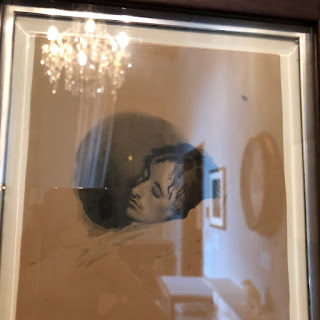Giornale - Keats-Shelly Memorial House
The last thing I wanted to hear while standing, a little dumbstruck, in John Keats’ tiny bedroom off of the Piazza del Popolo, was a man singing an off-key rendition of Miley Cyrus’ “Wrecking Ball” outside. I stood staring down at his writing desk, unsure if I was allowed to touch it, and tried my best to ignore the tinny, microphone notes floating through the open window. The grandeur of where I was standing was enough to ignore this fatal flaw of modernity as it pushed against the past I was attempting to step into for a moment.
The walk to the house with Claire was a peaceful one. The temperature had cooled off and we had changed into sneakers to try and sooth our feet a little. It worked, for at least a bit. The streets there were crowded with busy shoppers who floated in and out of large-windowed storefronts. The store keepers stood in the doorway in what Claire and I deemed an intimidating manor. They looked down from their perch in their expensive suits, as if challenging you to come in. A very different approach than those who step in front of you and tell you to sit down at their restaurant right this very moment.
The busy nature of Rome shifted when we entered the Piazza del Popolo. Instead of hearing a majority of Italian, the voices around us shifted and split into many languages, most of which seem to be arguing over the best angle for a selfie stick. Almost instantly, we spotted a man playing what at first glance appeared to be an electric violin. At second thought, however, his fingers moved much too rapidly to match any of the notes belonging to “Shape of You” by Ed Sheeran that was blaring through his speakers. The previously mentioned singer was there too, and it was quite the experience listening to them battle for dominance using two different tunes. The presence of such street performers, the abundance of them in Rome in particular, has always been interesting to me. This does not exist on such a large scale in New York City, but even if it did, I find myself thinking that I wouldn’t notice it as much. It may be the presence of these performers against the backdrop of ruins that makes them stick out so sorely.
Upon entering the museum, the first thing that caught my eye was a map of where famous authors lived in Rome. I immediately zeroed in on Henry James and snapped a picture to send to my dad, who has been writing a screenplay concerning his life and works. We purchased our tickets in the gift shop while being intently stared at by no less than six French small children, something I have never liked. Not French children, but the way children have of staring in general—extraordinarily focused, like they’ve never seen the likes of you before. The two young women who were working, one American and one German, were friendly and enthusiastic when I told them they have a dream job, nodding in agreement.
Upon walking upstairs, I was instantly surrounded by books. I could live always surrounded in books, beautiful behind their diamond-barred cases. Scattered around the room were relics of Shelly, Keats, and Byron, ranging from large ties of their hair, to bits of their ashes or pieces of the doors to their houses. It was fascinating to see these things next to, for example, the skull of Saint Agnes. Honestly, it helped me relate to the power that Christian relics hold for some people. Seeing the relic-like pages of Keats’ notebooks, filled with beautiful hand written first drafts and letters to his best friend Joseph Severn was as powerful to me as relics of Christ are to others.
The walls were unexpectedly lined with paintings and drawings of John Keats by his best friend Joseph Severn. One in particular was of Keats’ sleeping face, hair damp with the fever he had. Severn had titled it, “Drawn To Keep Me Awake” while he was watching over his sick friend. There was just as much love shown through these pieces of art as Keats returned in his words, including a letter he signs to Severn, “I am ever yours.” Even better, Claire and I visited her site the very next day, the Non-Catholic Cemetery, where Keats and Severn are buried side by side. As an aspiring fiction writer myself, seeing where Keats lived, wrote, and died in Rome and pacing his room as I like to think he often did while writing was an especially magical experience. Seeing his handwriting was one of my favorite parts.
In the gift shop I bought a book titled Keats on Love and another titled 30 Myths of The Romantics. I’m not sure how to fit them into my suitcase yet, but that’s a problem for another twelve days. Walking back, it began to rain lightly, something that felt fitting. Seeing Keats’ alarmingly tiny bed allowed how sick he was to set in, and the rain falling matched my thoughts on how young he died and how much he gave history in such a short amount of time. On his grave, he wanted written that his name was “writ in water.” Seeing his house, his picture, his journals, and how loved he was by his friends, I hope he knows that, although writ in water, his name has not washed away in the slightest.

Comments
Post a Comment